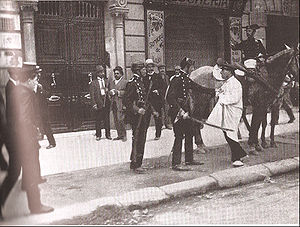Tragic Week (Spain)
You can help expand this article with text translated from the corresponding articles in Spanish and Catalan. (March 2018) Click [show] for important translation instructions.
|
| Tragic Week | |||
|---|---|---|---|
| Part of the Second Rif War | |||
 Suspects rounded up by the Civil Guard. | |||
| Date | 26 July – 2 August 1909 | ||
| Location | |||
| Caused by | Opposition to conscription and the Second Rif War Antimilitarism Anti-clericalism | ||
| Methods | Rioting, strikes, barricades, arson and murder | ||
| Parties | |||
| Casualties and losses | |||
| Arrests: 1,700 Injuries: 441[1] Deaths: 104 to 150 civilians and 8 military. Five further civilians were executed after the riots. | |||
Tragic Week (in Catalan la Setmana Tràgica, in Spanish la Semana Trágica) (25 July – 2 August 1909) was a series of violent confrontations between the Spanish army and anarchists, freemasons, socialists and republicans of Barcelona and other cities in Catalonia, Spain, during the last week of July 1909. It was caused by the calling-up of reserve troops by Premier Antonio Maura to be sent as reinforcements when Spain renewed military-colonial activity in Morocco on 9 July, in what is known as the Second Rif War. Many of these reservists were the only breadwinners for their families, while the wealthy were able to hire substitutes. The figureheads most associated with the unrest were Alejandro Lerroux and Francisco Ferrer.
Background
[edit]The incident began when a party of conscripts, destined for Morocco, boarded ships owned by the marquess of Comillas, a prominent Catholic industrialist. The soldiers were the subject of patriotic addresses, the playing of the Royal March, and the distribution of religious medals by well dressed ladies. The conscripts remained silent but many of the onlookers jeered and whistled, and emblems of the Sacred Heart were thrown into the sea.[2]

Outbreak
[edit]By Tuesday, workers had occupied much of central Barcelona, halting troop trains and overturning trams. By Thursday, there was street fighting, with a general eruption of riots, strikes, and the burning of convents. Many of the rioters were antimilitarist, anticolonial and anticlerical. The rioters considered the Roman Catholic Church a part of the corrupt middle and upper class whose sons did not have to go to war, and much public opinion had been turned against the Church by anarchist elements within the city. Thus, not only were convents burned, but sepulchers were profaned and graves were emptied.[3]
References
[edit]Sources
[edit]- (in English) Carolyn P. Boyd, Praetorian Politics in Liberal Spain, The Library of Iberian Resources Online
- (in English) Ullman, Joan Connelly. The Tragic Week: A Study of Anticlericalism in Spain, 1875–1912. Cambridge: Harvard University Press, 1968.
- Andreu Martín: Barcelona Trágica (Ediciones B, 2009 -castellano-); (Edicions Ara, 2009 -catalán-)
External links
[edit]![]() Media related to Setmana Tràgica at Wikimedia Commons
Media related to Setmana Tràgica at Wikimedia Commons
- 1909 in Spain
- 1909 riots
- Anarchism in Spain
- Anti-anarchism in Spain
- History of anarchism
- Military history of Barcelona
- History of Catalonia
- Riots and civil disorder in Spain
- 1909 in Catalonia
- July 1909 events
- August 1909 events
- Freemasonry-related controversies
- Freemasonry in Spain
- Terrorist incidents in Catalonia
- Terrorist incidents in the 1900s
- Rif War
- 1909 labor disputes and strikes
- General strikes in Spain
- Mass murder in 1909
- Arson in Spain
- 1909 fires
- Mass murder in Catalonia
- Massacres of protesters in Europe
- Massacres committed by Spain
- Anti-war protests
- Conscription crises
